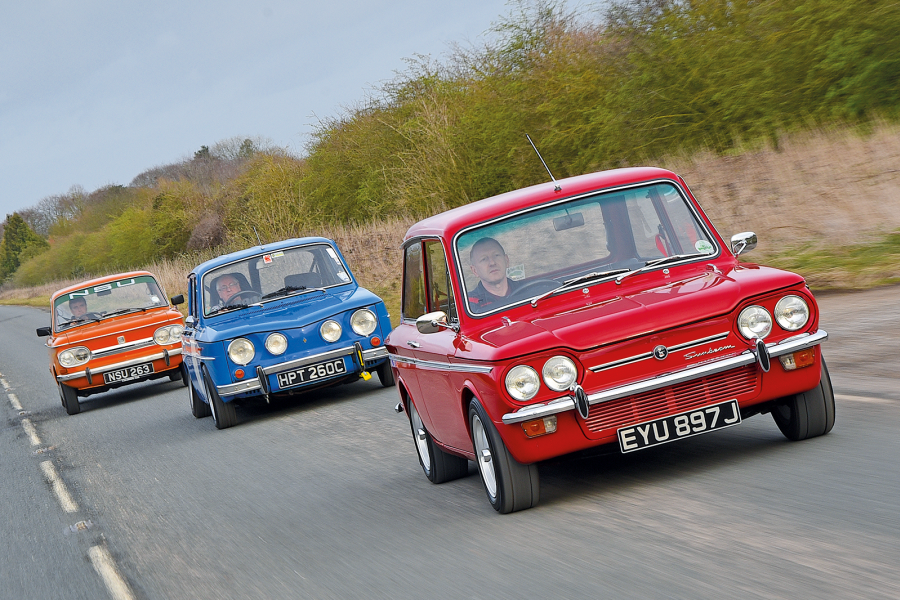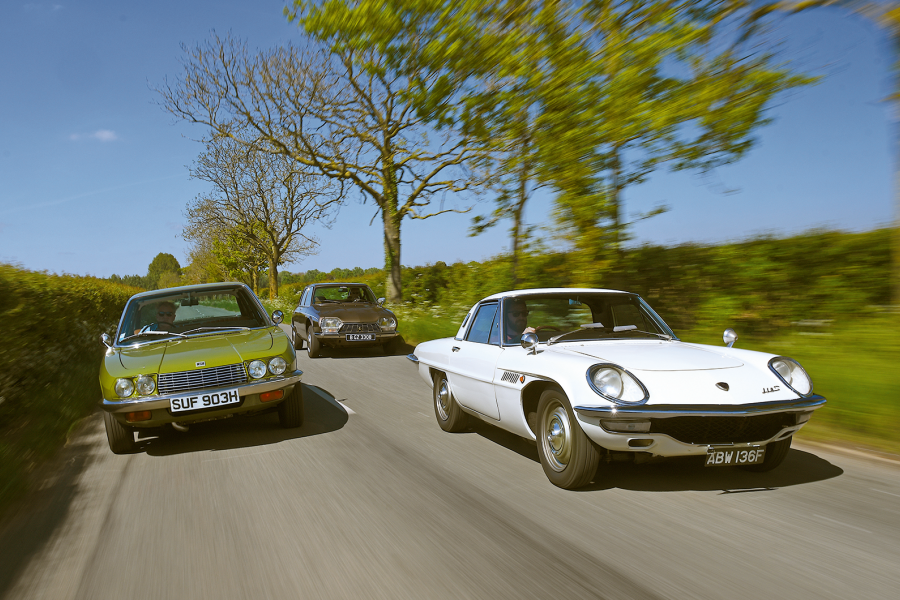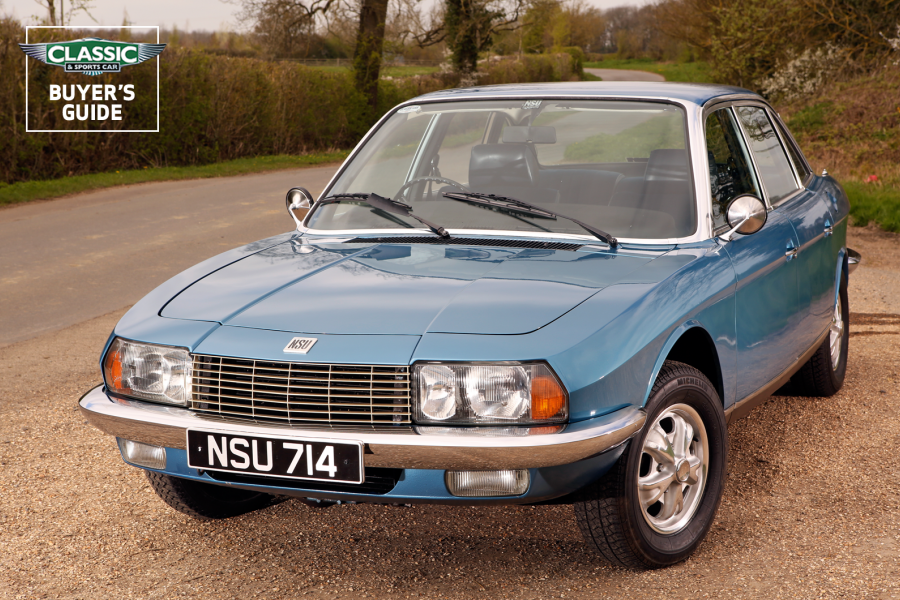The twin-Solex-carb TT had 69bhp, while the TTS homologation special – with forged pistons, extra-high compression ratio and wild cam timing – was good for up to 100bhp if you opted for the Group 2 tuning kit.
NSU claimed that the 100mph-plus TTS was the fastest 1-litre production car in the world even in standard 89bhp form, with a wide range of gear and final-drive ratios available depending on what you wanted to do with it.
For the not quite so wild TT, NSU upped the capacity to 1177cc to make the 1200TT in 1968, but kept the TTS at 998cc so as to maintain its competitiveness in sub-1-litre racing and rallying.
Tony Oldman is a service driver for Porsche who acquired his taste for Prinz motoring from a 1000C, but always wanted a TT. He bought this 1970 1200TT – one of maybe 10 in the UK – from its first owner 14 years ago.
The jacked-up engine lid isn’t for show, it helps cooling, while the chequer detailing reminds you it’s the ‘hot’ variant, with twin Solex carbs
Slightly more peak torque at much lower revs probably makes this a nicer all-round road car than the TTS. The only real internal evidence that you are driving the ‘hot’ variant is the rev counter and a sports wheel.
The handling does exactly your bidding and you are never made especially aware of the mass of machinery in the tail except in terms of noise.
With no water jacket, there’s an urgent ring to the engine and a constant whine from the transmission where top is indirect and two pairs of gears are always transmitting torque.
The gearchange itself feels disconnected: not vague, just fingertip light, fast and a joy to use.
The TT squats and pulls hard from 2000 to 6000rpm with another 1000 to go; 70mph comes up quickly before you have to change into top.
The sports steering wheel and rev counter denote this as a TT model
The 1200 range was a move in another direction. Germans were becoming more affluent and wanted bigger, more impressive-looking cars.
NSU’s response – the only one it could afford pending the introduction of the water-cooled, front-drive K70 in ’69 – was to stretch the Prinz’s wheelbase by 8in and give it a fake front ‘grille’.
Launched as the 1085cc Type 110 in 1965, it became the 1177cc 110SC in 1966.
NSU added to the confusion by almost immediately renaming this flagship Prinz derivative the 1200C.
‘Our’ 1971 car in Iberian Red belongs to Paul Burgess from south Wales and is one of only three 1200C Automatiks known to the club.
The faux grille was to give the 1200 a big-car look, and it is powered by an air-cooled ‘four’ that was bored out from 996cc to 1177cc
It is a semi-auto, in fact, like the one found in the Ro80 with a microswitch in the top of the gearknob that operates the clutch via a vacuum unit.
In other words, you move the gearstick around as required but there is no clutch pedal. It works surprisingly well, although the standard four-speed ’box is so sweet that you wonder who preferred this slightly clunky arrangement with a noticeable gap between second and third.
By the time this 1200C was being built, the fate of the baby NSUs had already been sealed.
Air-cooled rear-engined cars were increasingly out of favour with environmentalists because their emissions were more difficult to control, and with safety legislators because their handling – after Ralph Nader’s Unsafe at Any Speed – was not deemed to be as ‘safe’ as conventional cars.
Even if that was an unfair criticism of the nimble Prinz, nobody could deny that an NSU felt a bit dodgy on a windy motorway – like most of its ilk.
The seats in this 1200C are from a Metro GTI
But worst of all, they were out of favour with the public because rear-engined cars had an image problem that linked them with miserable post-war austerity motoring rather than the prosperous new horizons of the 1970s.
NSU was subsumed into Audi and, by extension, Volkswagen in 1969 and nobody shed a tear when the crisp new Polo in effect replaced the Prinz range two years after it was canned in ’75.
The noble failure of the Ro80 was underpinned by the decade and a half long success of this well-engineered breed of small rear-engined NSUs that came before it.
They now represent a long-lost world of Euro-austerity motoring in cars that were not sterile blobs of well-honed international uniformity, but had a strong national character and identity.
TT silhouette
This fearsome NSU TT special is based on a Lotus Europa Twin Cam chassis
Simon Sapsted’s squat black TT special is really an NSU in name and body panels only.
Under the skin lurks a Lotus Europa Twin Cam chassis powered by a ‘red top’ Astra GTE 2-litre engine with a Renault 21 gearbox, the latter a popular item with Ford GT40 replica-makers because of its inherent strength.
The TT shell was acquired 27 years ago in a totally rotten state for £75.
This TT special has a stripped-out cabin and Vauxhall Astra-sourced engine
Sapsted joined the NSU OC and, after getting an angle grinder as a Christmas present, set to work uniting it with the mid-engined Lotus chassis (that just happens to have a similar wheelbase).
This turned into a near-five-year project. You may have seen the car at the Brighton Speed Trials (98mph across the line) or doing 102-second Goodwood laps at 99mph.
So, yes, it’s rather quick, with a raucous exhaust note, few creature comforts – but a recognisably NSU dash – and responsive handling. Plus, there’s more power and torque than the Europa ever had, so you can flick the tail at will. It’s great fun, even if it doesn’t have much to do with a Prinz!
Images: Tony Baker
Thanks to the NSU Owners’ Club
This was originally in our August 2014 magazine; all information was correct at the date of original publication
READ MORE
Separated at birth: Volkswagen K70 vs NSU Ro80
Is the NSU Ro80 the greatest saloon ever made?
Rotary club: Mazda Cosmo, NSU & Citroën
Off the Rekord: forgotten Opels
Martin Buckley
Senior Contributor, Classic & Sports Car





































